6 Essential Steps to Building an Outdoor Kitchen
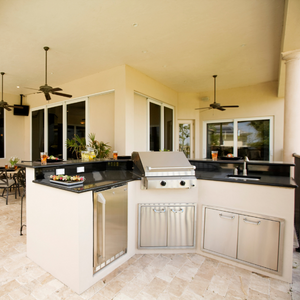
Before adding or building an outdoor kitchen, there are a few preliminary steps you should take and special considerations to know. Here are six important things you need to do when building your perfect outdoor oasis.
Step #1: Create a Budget
If you’ve never undertaken construction or renovations before, you might not have any idea about what things cost beyond a rough estimate of “several thousand dollars.” So how do you go about creating a budget? Research is the key.
Start with a mood board, where you gather ideas for what you want, including materials, appliances, and so on. A great place to do this is on Pinterest. This social platform is basically a searchable, free catalog of inspiration for your home. With Pinterest, you have the opportunity to take the reins and do your own research, finding the design elements that best suit your needs and style preferences.
With a few major details in mind, you can get at least a rough estimate of material costs. Next, you’ll have to start getting bids from contractors to determine the labor.
It’s always best to start by knowing your limit. This includes any money you have on hand to devote to the project and what you could get from an equity line (check with your preferred lender). You can offset this against what you personally feel comfortable spending or borrowing, as well as potential returns on your investment.
Step #2: Comprehensive Layout and Design
In design, form follows function. Before you decide on appliances and materials, you need to plan the layout of your outdoor kitchen. There are a few things to consider in the process.
Pick a Practical Location
Generally, the ideal spot for your outdoor kitchen is as close as possible to your indoor kitchen, with a door between the two that makes it easy to transition food, drinks, and dishes between indoors and out.
No matter how great your outdoor kitchen is, chances are that it won’t have a dishwasher. You also won’t fit everything you need in a mini-fridge. In other words, some amount of sharing between indoor and outdoor spaces will still occur.
Take Precise Measurements
This milestone is absolutely essential. As the saying goes, measure twice, cut once. With accurate measurements, you can determine the layout that works with your current patio, or alternately, decide whether you want to cut into yard space to accommodate a more functional or aesthetically pleasing outdoor kitchen. You can find a landscape designer or landscape contractor near you on Houzz that has expertise in measuring and designing these spaces.
Select Your Layout and Counter Shape
With I-shape, L-shape, U-shape, and other counter options to choose from, you might have trouble deciding on the best layout for your outdoor kitchen. There are two main things to consider here: available space and function.
Read our blog “How to Measure Countertops in 4 Easy Steps”
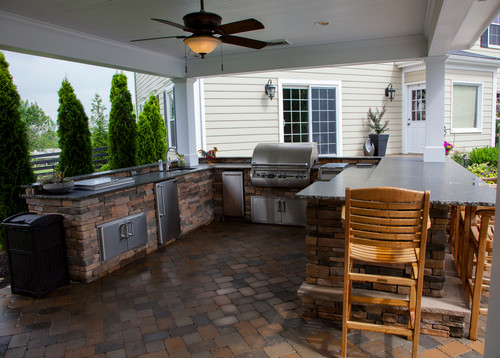
From a functional standpoint, a U-shape, like this entertainer’s backyard, is ideal, as it allows for the best placement of your kitchen triangle (sink, fridge, and cooktop area).

However, if you don’t have a ton of space to work with, an L-shape, like this custom outdoor kitchen, is the next best choice.
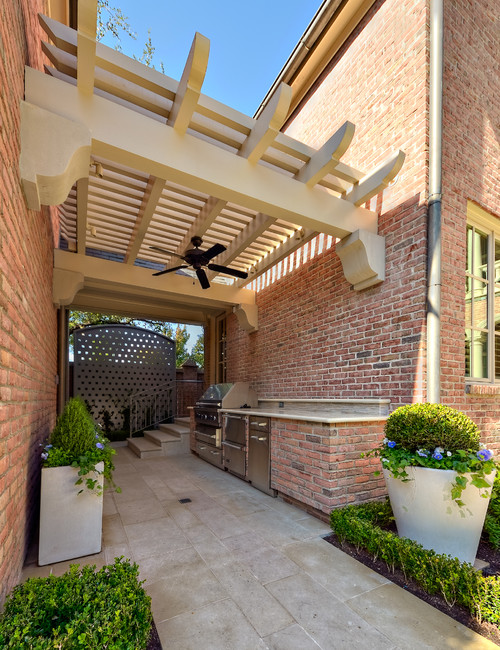
I-shaped kitchen counters, as seen on this small, traditional patio, are best when you need a space-saving option.
Plan for Seating
The whole point of an outdoor kitchen is to enhance your outdoor dining experience. It’s easy to get wrapped up in the kitchen design and forget to plan for an adequate dining area.
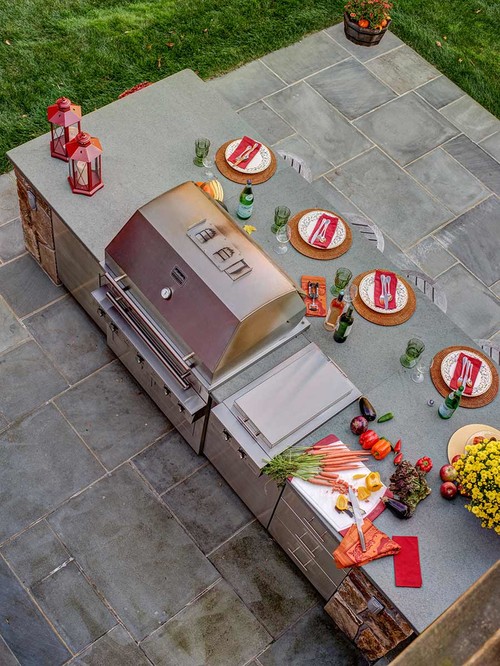
Whether you’re creating an island or peninsula with bar seating, as on this Connecticut farmhouse patio, or you’re leaving room for a separate dining area, like this transitional outdoor kitchen deck below, it’s important to include this detail as part of the planning process.
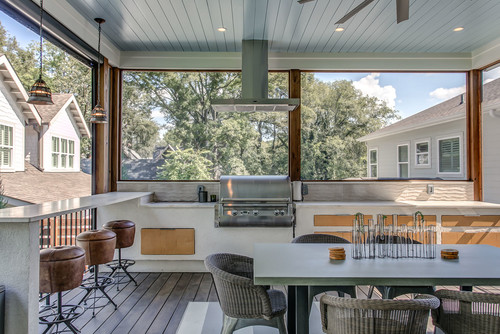 #4: Consider Appliances
#4: Consider Appliances
Now that you’ve got your budget and layout ready, it’s time to consider appliances. A grill is obviously essential to any outdoor kitchen, while a mini-fridge is going to save you trips to the indoor kitchen.
However, you may also want to include handy extras, like a warming drawer if you frequently grill in batches, as well as a cooktop for boiling water or cooking side dishes. Other luxury add-ons could include a smoker, a spit, a pizza oven, or a fireplace, for example.
#5: Choose Outdoor Countertop Materials
Once you’ve got functionality on lockdown, it’s time for the fun part – choosing the countertops. Natural stone countertops such as granite or quartzite are ideal choices for outdoor use and stand up to the outside elements well. There are minor differences in the durability of granite and quartzite. Measured by resistance to scratching, granite is rates a 6-6.5 on the Mohs hardness scale. Quartzite contains quartz which is harder than granite. Quartzite rates a 7 on the Mohs hardness scale. These countertops are intended to last as long as the home, or at least until a homeowner changes their tastes in décor.
Dekton Ultra Compact Surface is a great outdoor manufactured countertop material that comes highly recommended. Dekton also comes with a 25-year warranty. According to Dekton’s maintenance guide, when properly installed and maintained, it’s unlikely to be damaged by any common circumstance.
#6: Hire Professional Services
While many homeowners elect to save money by doing some of the work themselves, you could end up in over your head, especially if you make rookie mistakes that eat into your budget.
Make sure to get breakdowns of bids from contractors so you can pick and choose the services you want and save some money on the stuff you feel comfortable handling on your own.
Are you ready to start looking at countertop materials for your outdoor kitchen? Check out our portfolio for design inspiration.


